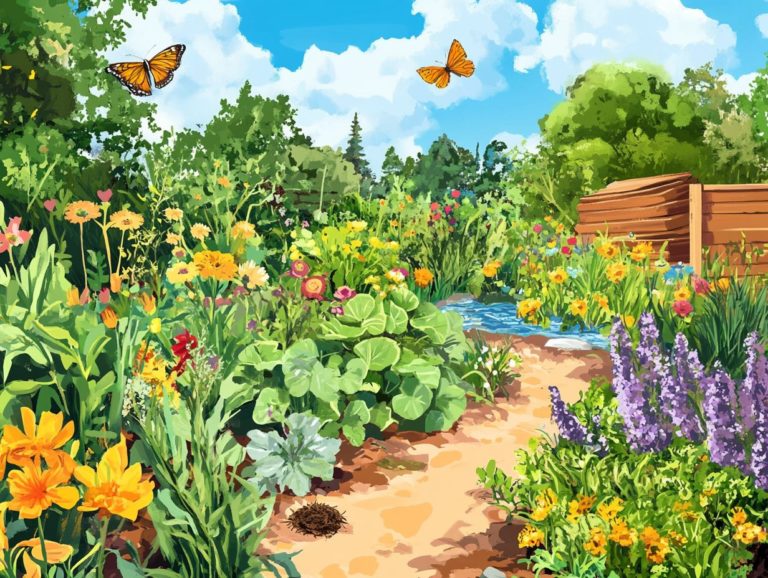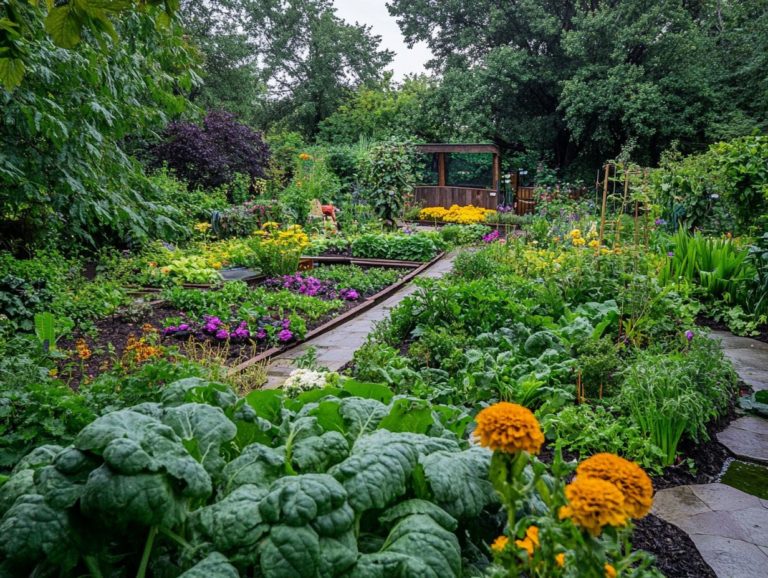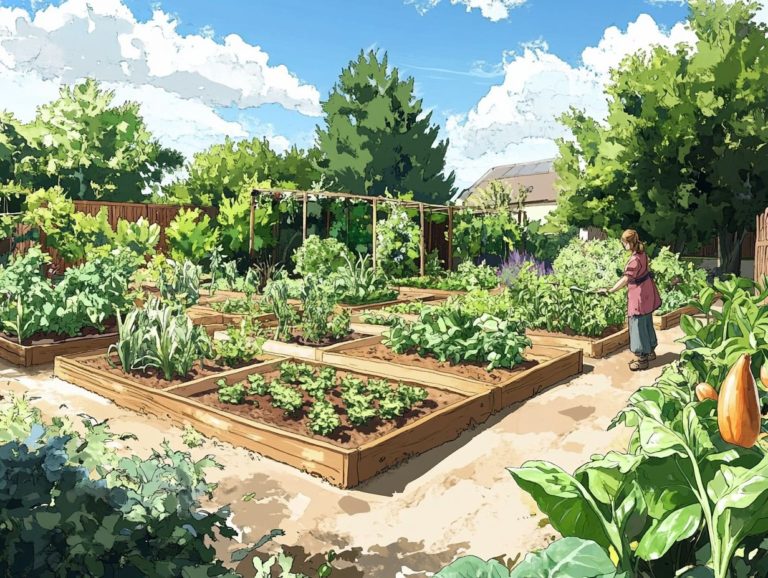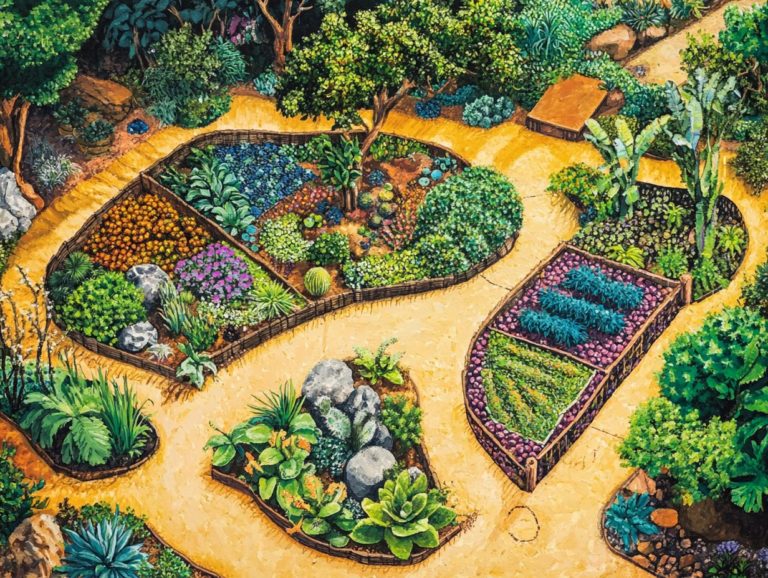Permaculture Design: Importance of Soil Layers
Permaculture design presents a comprehensive method to sustainable living. It invites you to work in harmony with nature rather than against it, promoting sustainability and biodiversity.
At the heart of this philosophy lies a deep appreciation for soil layers. These layers play a vital role in nurturing a healthy ecosystem and contribute to carbon capture and overall ecosystem health.
You ll explore the foundational principles of permaculture. Delve into the intricacies of soil health and uncover practical strategies to create and sustain a thriving soil ecosystem, essential for nutrient cycling.
Whether you re a seasoned gardener or just beginning your journey, you ll learn how to integrate soil layers into your designs for lasting success.
Start your adventure in sustainable gardening now! Join this exciting journey to enrich your gardening practices and cultivate a deeper connection with the earth.
Contents
- Key Takeaways:
- The Basics of Permaculture Design
- The Role of Soil Layers in Permaculture
- Creating a Healthy Soil Ecosystem
- Utilizing Soil Layers in Permaculture Design
- Incorporating Soil Layers into Garden Layouts
- Maintaining Soil Layers for Long-Term Success
- Best Practices for Sustaining Soil Health
- Frequently Asked Questions
- What is Permaculture Design and why is it important for sustainable soil layers?
- What are the different layers of soil and why are they important in Permaculture Design?
- How does Permaculture Design improve soil layers?
- Why is soil health important in Permaculture Design?
Key Takeaways:
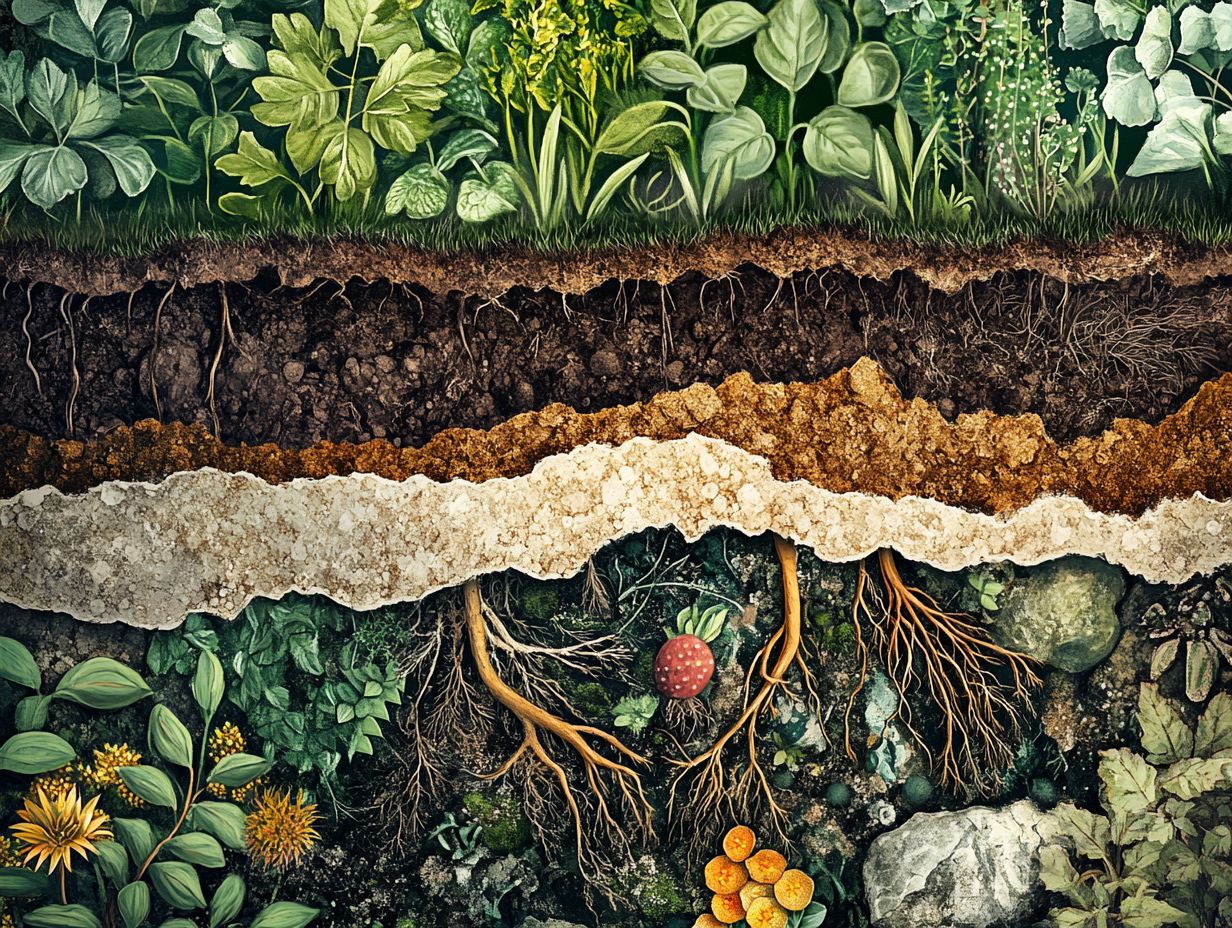
- Permaculture design relies heavily on the health of soil layers, which support the growth of plants and the entire ecosystem.
- Understanding the various layers of soil is crucial in creating a healthy soil ecosystem, essential for successful permaculture practices.
- Incorporating and continuously maintaining soil layers in permaculture design leads to long-term success and sustainability for your garden, supporting effective land management and conservation practices.
The Basics of Permaculture Design
Permaculture design offers you a comprehensive method for crafting sustainable agricultural practices. These practices align seamlessly with nature, emphasizing ecological balance and community involvement.
This approach highlights the critical importance of fostering healthy ecosystems and biodiversity. It also optimizes soil health and resource utilization.
By embracing permaculture principles, you cultivate responsible stewardship of natural resources. Integrating ecological balance into your practices helps mitigate greenhouse gas emissions.
It also highlights the importance of community involvement in sustainable efforts. This empowers you to restore and maintain ecosystems effectively through partnerships and education.
Defining Permaculture and its Principles
Permaculture is centered on its core principles that champion sustainable land management, resource conservation, and the promotion of biodiversity. These are crucial for ecosystem services.
These principles aim to create agricultural systems that closely resemble natural ecosystems. This allows you to use resources efficiently while enhancing ecological balance and fostering healthy relationships between organisms.
For instance, consider integrating organic matter through composting. This approach greatly improves soil fertility and contributes to the nutrient cycle, enhancing overall soil health.
Another effective strategy is companion planting. Grow certain crops together to mutually benefit one another, improving biodiversity and soil structure. This technique helps reduce pests organically and boosts overall yields, promoting sustainable agricultural practices.
By adopting these core principles, you can cultivate a resilient environment that supports local wildlife. This conserves water and fosters a thriving community of plants and animals, ultimately paving the way for sustainable agricultural practices.
The Role of Soil Layers in Permaculture
Soil layers are essential in permaculture, serving as the foundation for thriving ecosystems and supporting carbon capture. Understanding the importance of soil health in permaculture enables nutrient cycling, maintains soil fertility, and prevents erosion, which are vital for sustainable agricultural practices.
Understanding this foundation can significantly enhance your approach to permaculture. It contributes to a more balanced and resilient environment, crucial in the face of climate challenges.
The Importance of Soil Health
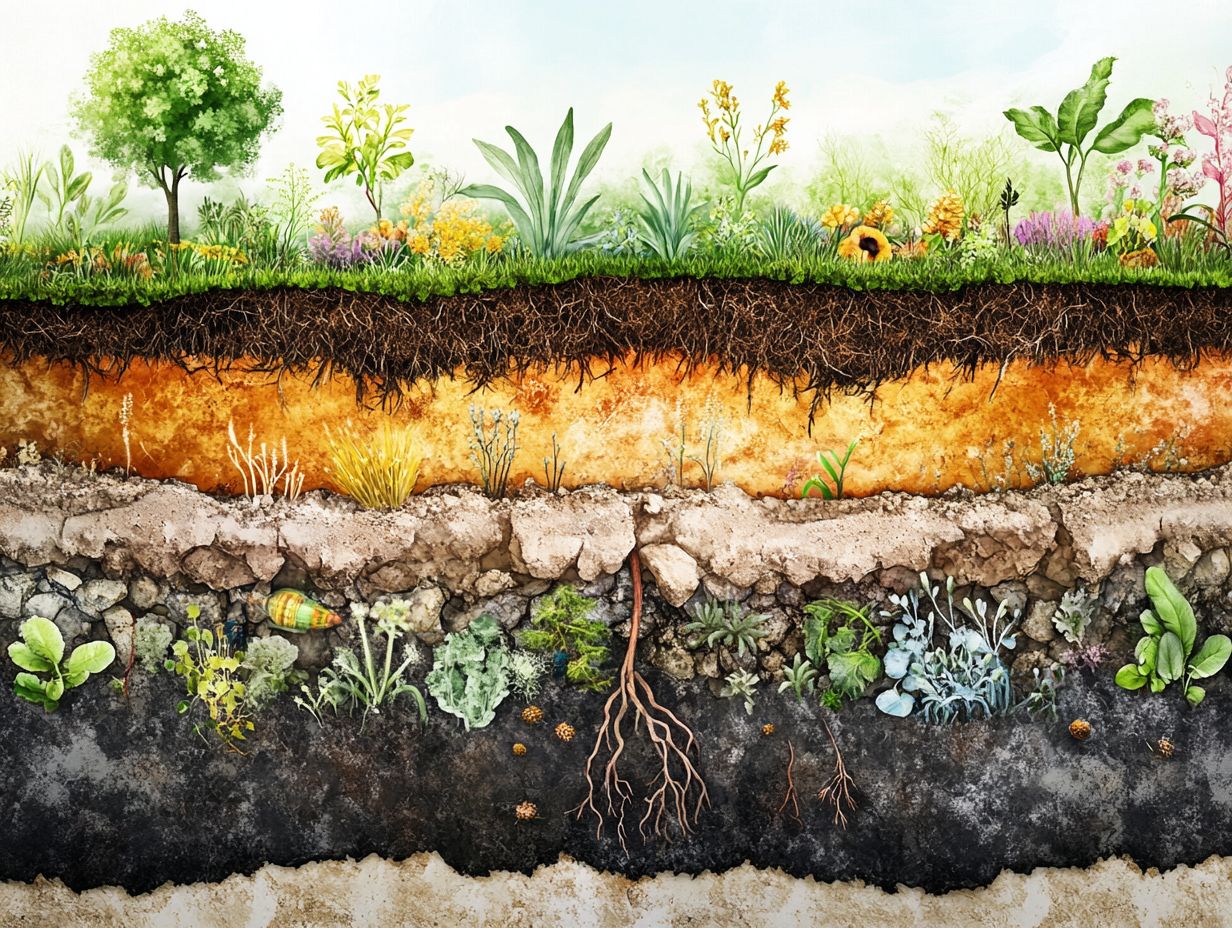
Healthy soil is paramount for maintaining the delicate balance of ecosystems, supporting biodiversity, and ensuring that essential nutrients are readily available for both plants and organisms. This is crucial for ecosystem health.
When you manage soil effectively, you’re not just enhancing crop yields; you’re cultivating a vibrant ecosystem where diverse organisms can coexist harmoniously. These organisms contribute to carbon cycling and overall ecosystem services. The intricate web of life beneath the surface has a direct influence on the types and availability of nutrients, crafting a fertile environment that nurtures plant health.
Engaging in composting organic matter serves as a vital sustainable practice that enriches soil quality. It bolsters microbial diversity and promotes healthy interactions within the ecosystem. Start incorporating these sustainable methods today and see the difference!
Understanding the Different Layers of Soil
The various layers of soil, each with its distinct structures and functions, are essential to the nutrient cycling processes that support a myriad of organisms crucial for ecosystem health. This understanding enhances agricultural practices.
By appreciating the composition of these layers, you can see how they interact to facilitate the transfer of nutrients and moisture, promoting better resource management. The top layer, rich in organic material known as humus a rich layer of organic material that feeds plants is a vital habitat for diverse microorganisms that contribute to breaking down organic materials, thus enriching the soil and enhancing its fertility.
Beneath this surface layer, the subsoil retains minerals and nutrients, serving as a reservoir that bolsters plant growth, essential for sustainable agricultural practices. The deeper layers, often made up of weathered rock, provide a stable foundation for soil while also playing a significant role in groundwater filtration.
Collectively, these layers create a dynamic environment where organisms flourish, significantly contributing to the maintenance of ecological balance and enhancing biodiversity.
Creating a Healthy Soil Ecosystem
To build a thriving soil ecosystem, try these exciting strategies that enhance organic matter content, promote biodiversity, and conserve resources. This thoughtful approach helps farming practices become more resilient and supports sustainable land management for the long term, enhancing community engagement.
Strategies for Improving Soil Health
- Utilize compost to enrich your soil with organic matter, promoting beneficial microbial activity and enhancing nutrient availability.
- Incorporate cover crops like legumes to fix nitrogen in the soil, prevent erosion, and suppress weeds, contributing to nutrient cycling.
- Use mulching to preserve soil moisture and regulate temperature, creating a balanced and thriving ecosystem that supports biodiversity.
- Consider methods like no-tillage to minimize disruption of soil layers and foster a welcoming habitat for earthworms and other essential organisms.
By integrating these sustainable techniques, you can cultivate a vibrant environment that not only supports plant health but also boosts biodiversity and contributes to ecosystem services.
Utilizing Soil Layers in Permaculture Design
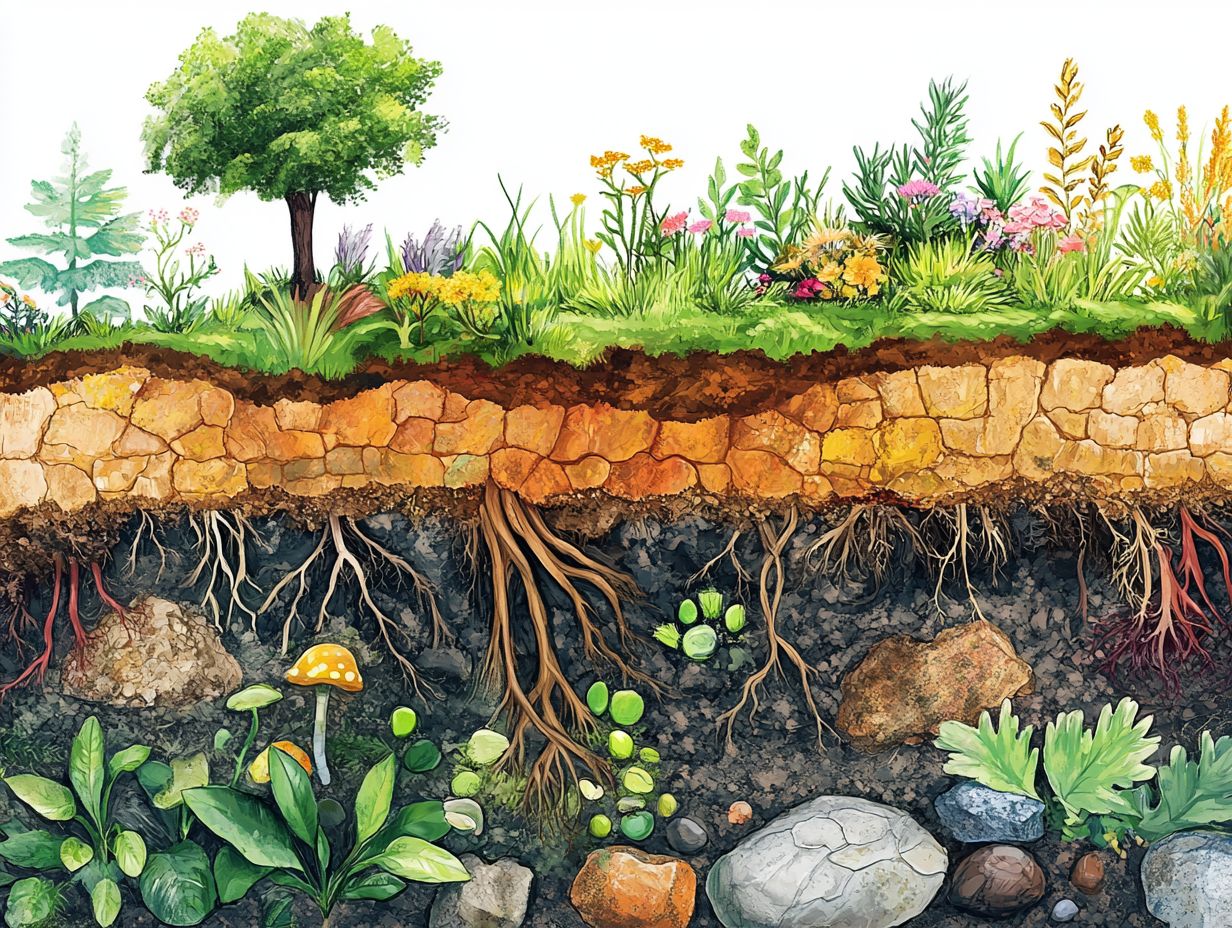
By effectively utilizing soil layers in your permaculture design, you enhance your garden layout, promote efficient nutrient cycling, and strengthen the ecosystem services that are essential for sustainable agriculture. Understanding the importance of soil structure in permaculture fosters environmental stewardship.
Join the movement for healthier soil and a better planet!
Incorporating Soil Layers into Garden Layouts
Incorporating soil layering in gardening into your garden layouts is crucial for maximizing biodiversity. This practice ensures effective conservation within permaculture systems and promotes community engagement.
By thoughtfully designing these layers, you can promote healthier ecosystems. You will create a thriving environment for various plant species and soil organisms, enhancing ecological balance.
Techniques such as layering organic materials, utilizing cover crops, and implementing methods that help the soil recover will contribute to nutrient cycling. These practices improve soil texture, which is vital for sustainable land management.
These methods not only support a diverse array of flora and fauna but also enhance water retention and reduce erosion.
A well-structured garden design today can bring lasting benefits! It fosters resilience and reduces your dependency on synthetic inputs, creating a harmonious balance within the ecosystem and promoting environmental sustainability.
Maintaining Soil Layers for Long-Term Success
Keeping your soil layers healthy is the key to thriving gardens! It demands your consistent care and sustainable practices, along with a commitment to responsible land stewardship.
By doing so, you can ensure the health and stability of ecosystems, creating a thriving environment for all that grows within it.
Best Practices for Sustaining Soil Health
To sustain soil health, embrace best practices that include:
- Incorporating organic materials
- Using conservation techniques
- Regularly monitoring nutrient levels
These steps are essential for overall fertility and ecosystem health. They not only enhance the fertility of your land but also foster a resilient environment capable of withstanding climate fluctuations.
Incorporating cover crops like clover or rye can significantly reduce soil erosion and improve water retention. These practices enhance soil structure and foster a resilient ecosystem.
Applying compost or well-rotted manure enriches nutrient content, creating a balanced ecosystem bustling with beneficial microbes.
Techniques such as crop rotation changing the types of crops grown in a specific area and reduced tillage disturbing the soil less to preserve its structure help maintain soil health and biological diversity.
Engaging in proper mulching and utilizing organic fertilizers minimizes chemical runoff. This ultimately supports both agricultural productivity and ecological integrity, contributing to responsible land management.
Start applying these practices today and watch your garden flourish!
Frequently Asked Questions
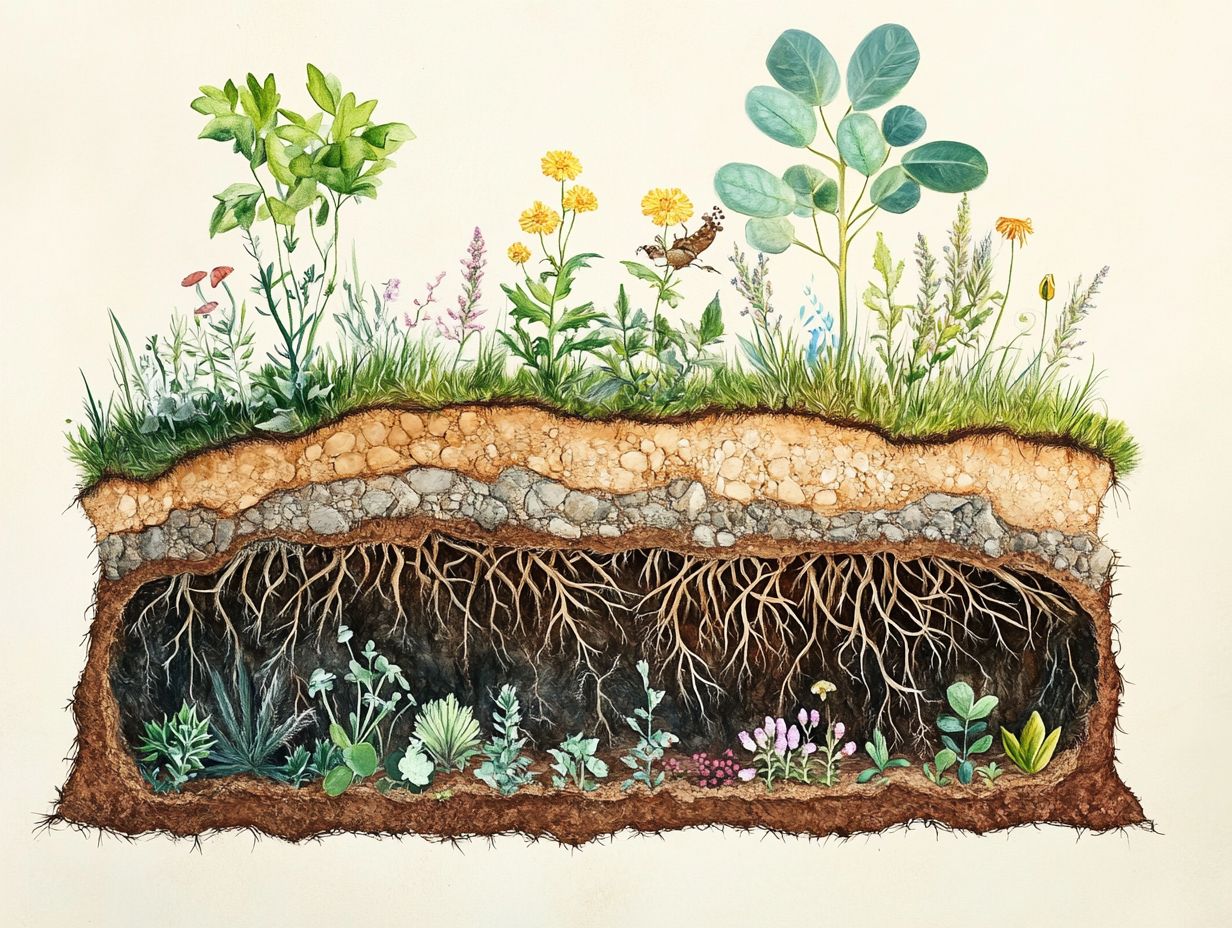
What is Permaculture Design and why is it important for sustainable soil layers?
Permaculture Design is a sustainable approach to agriculture that focuses on mimicking natural ecosystems. It is important for soil layers because it aims to improve soil health and structure, leading to greater plant growth and diversity.
What are the different layers of soil and why are they important in Permaculture Design?
The different layers of soil include topsoil, subsoil, and bedrock. These layers are important in Permaculture Design because they each play a role in nutrient cycling, water retention, and overall soil health, supporting biodiversity and ecological balance.
How does Permaculture Design improve soil layers?
Permaculture Design improves soil layers by utilizing techniques such as no-till farming, cover cropping, and crop rotation. These essential agricultural practices help to increase organic matter, improve soil structure, and support diverse microbial communities and organisms that contribute to soil fertility.
Why is soil health important in Permaculture Design?
Soil health is crucial in Permaculture Design because it is the foundation for growing healthy and productive plants, thereby enhancing ecosystem services. Healthy soil supports a diverse range of microorganisms, which help to break down organic matter and provide essential nutrients for plants.
What are some benefits of using Permaculture Design for soil layers?
Permaculture Design improves plant growth and yield. It also increases biodiversity, reduces erosion, and prevents nutrient loss.
This design helps store carbon, enhancing air quality. Overall, it fosters a sustainable and resilient ecosystem.
How can I implement Permaculture Design principles for soil layers in my own garden?
Start implementing Permaculture Design in your garden today! Use techniques like mulching, composting, cover crops, and intercropping.
These methods build healthy soil and promote a natural balance. They enhance the relationship between organisms and their habitats.

